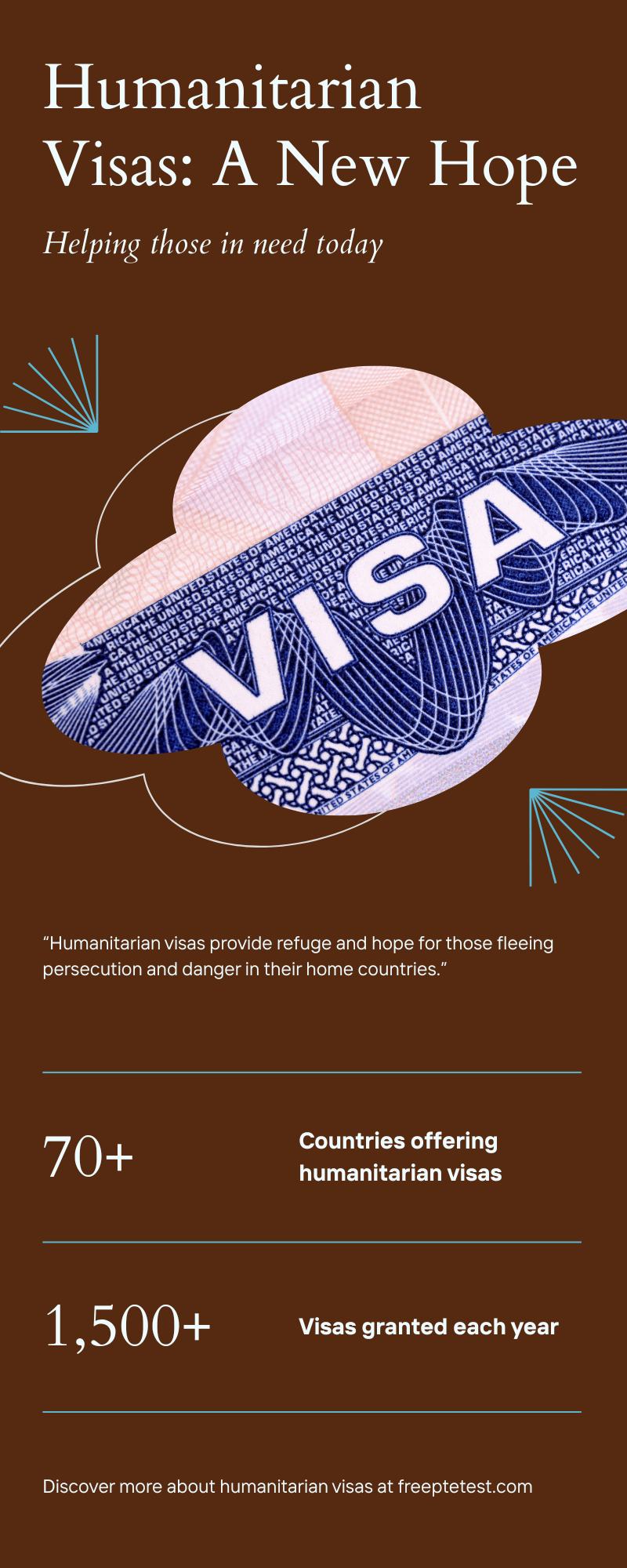Australia’s Humanitarian Visa Program offers a lifeline to individuals facing persecution, discrimination, or significant human rights abuses in their home countries. Designed to provide protection and resettlement opportunities, the program includes various visa subclasses tailored to refugees and those in humanitarian need.
As of September 2025, the Australian government has introduced updates to its Humanitarian Program, reflecting global displacement trends and enhancing pathways for resettlement.
These updates include an expansion of the Skilled Refugee Labour Agreement Pilot, increased community sponsorship places, and a proposed Urgent Humanitarian Response Visa.
This article provides a detailed guide to Australia’s humanitarian and refugee visas, their eligibility criteria, application processes, required documentation, and the latest 2025 updates, with preparation insights using FreePteTest resources.
Overview of Australia’s Humanitarian Program
Australia’s Humanitarian Program, administered by the Department of Home Affairs, is a cornerstone of the country’s commitment to international protection obligations.
It comprises two main streams: the offshore resettlement program for individuals outside Australia and the onshore protection program for those already in the country.
The program aims to resettle refugees, support family reunification, and address global humanitarian crises, with a focus on protection needs and Australia’s capacity to integrate newcomers.
In 2025, the program is set at 20,000 places annually, though advocacy groups like the Refugee Council of Australia (RCOA) push for an increase to 27,000 to meet rising global demand.
Key principles include prioritizing protection, promoting family unity, and adopting a whole-of-government approach to resettlement.
The 2025 updates emphasize flexibility in responding to emerging crises, such as conflicts in Gaza and Sudan, and enhance pathways like the Skilled Refugee Labour Agreement Pilot, targeting 500 primary visas by year-end. Freeptetest resources provide guidance on navigating these updates for visa applicants.
Types of Humanitarian and Refugee Visas
Australia offers several visa subclasses under its Humanitarian Program, each with specific eligibility criteria and purposes. Below is an updated overview of the main visa types for 2025, reflecting the latest changes.
Offshore Resettlement Program
These visas are for individuals outside Australia who face persecution or significant harm and lack other durable solutions.
- Refugee Visas (Subclasses 200, 201, 203, 204)
- Purpose: Permanent visas for refugees outside their home country with a well-founded fear of persecution due to race, religion, nationality, political opinion, or membership in a particular social group.
- Eligibility: Applicants must be outside Australia and their home country, identified as refugees by the UNHCR or Australian authorities, and have no other country available for resettlement. Priority is given based on protection needs.
- Benefits: Permanent residency, work and study rights, access to Medicare, and eligibility to apply for citizenship after meeting residency requirements.
- 2025 Updates: Increased focus on regions with urgent resettlement needs, such as Afghan and Sudanese cohorts, with streamlined processing for UNHCR-referred cases.
- Global Special Humanitarian Visa (Subclass 202)
- Purpose: Permanent visa for individuals facing substantial discrimination or human rights abuses (not necessarily refugee status) with a proposer in Australia.
- Eligibility: Applicants must be outside Australia and their home country, face significant discrimination amounting to gross human rights violations, and have a proposer (Australian citizen, permanent resident, or organization). Family members of proposers with Protection or Resolution of Status visas are prioritized.
- Benefits: Permanent residency, work and study rights, access to public healthcare, and the ability to propose family members for permanent residence.
- 2025 Updates: The Community Support Program (CSP) under Subclass 202 aims to increase to 10,000 places annually, with no visa application charge unless proposed under CSP. Online application options have been expanded for proposers.
Onshore Protection Program
These visas are for individuals in Australia seeking protection, typically those who entered legally or illegally.
- Permanent Protection Visa (Subclass 866)
- Purpose: Permanent visa for individuals in Australia who meet refugee or complementary protection criteria.
- Eligibility: Applicants must be in Australia on a valid visa, demonstrate a well-founded fear of persecution or significant harm (e.g., death penalty, torture, degrading treatment) if returned to their home country.
- Benefits: Permanent residency, work and study rights, travel freedom, and access to settlement services like English tuition.
- 2025 Updates: The Administrative Review Tribunal (ART), established in 2024, has processed over 10,000 protection appeals by May 2025, improving review efficiency for Subclass 866 refusals.
- Temporary Protection Visa (Subclass 785)
- Purpose: Temporary visa (up to 3 years) for individuals who entered Australia without a valid visa and meet protection criteria.
- Eligibility: Applicants must be unauthorized maritime arrivals or illegal entrants, proving a well-founded fear of persecution or significant harm.
- Benefits: Work and study rights, access to social benefits, but no travel outside Australia without permission.
- 2025 Updates: A temporary humanitarian visa pathway, introduced in October 2024 for Palestinian and Israeli nationals affected by the Israel-Hamas conflict, has granted 995 Subclass 785 visas by January 2025, with 210 under Subclass 449 (Temporary Safe Haven) as a first stage.
- Safe Haven Enterprise Visa (Subclass 790)
- Purpose: Temporary visa (up to 5 years) for illegal entrants engaging in work or study in regional Australia.
- Eligibility: Similar to Subclass 785, with additional pathway requirements for transitioning to other visas (e.g., skilled or family visas) after meeting work/study conditions.
- Benefits: Work and study rights, access to Medicare, and potential pathways to permanent residency.
- 2025 Updates: Enhanced pathways for Subclass 790 holders to apply for Resolution of Status (Subclass 851) visas, similar to those offered to Ukrainians post-2022.
- Urgent Humanitarian Response Visa (Proposed for July 2025)
- Purpose: A new temporary visa category to address urgent humanitarian crises, allowing flexibility for return or permanent residency post-crisis.
- Eligibility: Details are pending, but it targets individuals affected by sudden crises (e.g., conflict, natural disasters) with urgent protection needs.
- Benefits: Temporary stay with work and study rights, potential pathways to permanent visas.
- 2025 Updates: Proposed by the Parliamentary Budget Office (PBO), this visa aims to enhance Australia’s responsiveness to global emergencies, with implementation planned for July 2025.
Eligibility Criteria
To qualify for humanitarian or refugee visas, applicants must meet specific criteria:
- Refugee Status: A well-founded fear of persecution based on race, religion, nationality, political opinion, or social group membership, with no safe return to their home country.
- Complementary Protection: Risk of significant harm (e.g., torture, death penalty) if returned, even if not meeting refugee criteria.
- Location: Offshore visas (200, 201, 202, 203, 204) require applicants to be outside Australia and their home country. Onshore visas (785, 790, 866) require presence in Australia, legally or illegally.
- Proposer (Subclass 202): A proposer (Australian citizen, permanent resident, or organization) is mandatory, with priority for immediate family members.
- Health and Character: Applicants must meet health checks (e.g., medical examinations) and character requirements (e.g., no criminal history).
- No Other Solutions: Applicants must demonstrate no other country can provide protection or settlement.
The 2025 updates emphasize prioritizing protection needs and family unity, with faster processing for complete applications.

Required Documentation
Applying for a humanitarian or refugee visa requires comprehensive documentation, which varies by subclass. Below is a general list, updated for 2025:
- Valid Passport: Or other identity documents if a passport is unavailable (e.g., ImmiCard for those without travel documents).
- Visa Application Forms: Form 842 for Subclass 202; specific forms for other subclasses available via freeptetest guides.
- Photographs and Biometrics: Two recent passport-sized photos and biometric data (e.g., fingerprints).
- Family Certificates: Birth, marriage, or relationship certificates to verify family ties.
- Health Requirements: Medical examination results from approved providers.
- Character Documents: Police clearance certificates or statutory declarations.
- Australia’s Values Statement: A signed commitment to abide by Australian laws and values.
- Proof of Humanitarian Circumstances: Evidence of persecution or discrimination (e.g., UNHCR registration, affidavits, or media reports).
- Proposer Documents (Subclass 202): Form 681 or equivalent, detailing the proposer’s status and relationship to the applicant.
- Parental Consent (if applicable): Form 1229 for minors or a statutory declaration.
- Previous Visas: Copies of earlier visa grants or refusals.
For humanitarian parole (e.g., urgent travel), additional forms like the Application for Travel Document and Affidavit of Support are required. Freeptetest provides templates and checklists to ensure complete applications, reducing processing delays.
Application Process and Processing Times
Offshore Visas
- Application: Lodged online via ImmiAccount or through a proposer for Subclass 202. Applicants are interviewed by immigration officers to assess claims.
- Processing: Can take several months to years due to high demand (far exceeding the 20,000 annual places). Complete applications are processed faster, with 2025 updates improving online submission efficiency.
- Outcome: Applicants receive a written notification of approval or refusal. Approved applicants must enter Australia by the specified visa grant date.
Onshore Visas
- Application: Lodged through ImmiAccount or at a Department of Home Affairs office. Legal entrants apply for Subclass 866; illegal entrants apply for Subclass 785 or 790.
- Processing: Varies by complexity, with Subclass 785 and 790 processing accelerated for urgent cases (e.g., Gaza conflict applicants). ART reviews for refusals take 6–12 months.
- Outcome: Successful applicants receive permanent or temporary residency, with access to settlement services.
The 2025 updates prioritize complete applications and introduce faster ART reviews, reducing backlogs for onshore applicants.
2025 Updates to the Humanitarian Program
The following updates, effective as of September 2025, enhance Australia’s Humanitarian Program:
- Skilled Refugee Labour Agreement Pilot: Expanded to deliver 500 primary visas by 2025, targeting skilled refugees for regional employment.
- Community Support Program (CSP): Aiming for 10,000 places annually under Subclass 202, encouraging community sponsorship for resettlement.
- Urgent Humanitarian Response Visa: Proposed for July 2025 to address sudden crises, offering temporary protection with potential permanent pathways.
- Online Application Enhancements: Humanitarian visas now support online submissions for proposers, improving accessibility and reducing delays.
- Focus on Specific Cohorts: Prioritized processing for Afghan and Sudanese refugees, reflecting global displacement trends.
- ART Efficiency: Over 10,000 protection appeals finalized by May 2025, streamlining onshore visa reviews.
Freeptetest offers updated guides on these changes, including application tips and eligibility checklists.
Preparation Strategies with freeptetest
Navigating the humanitarian visa process requires thorough preparation. Freeptetest provides resources to assist applicants:
- Understand Visa Types: Use freeptetest guides to identify the appropriate visa subclass (e.g., 202 for offshore applicants with proposers).
- Document Preparation: Follow freeptetest checklists to compile complete documentation, avoiding delays.
- Evidence of Persecution: Freeptetest templates help draft affidavits or statements proving humanitarian circumstances.
- Proposer Coordination: For Subclass 202, freeptetest provides proposer forms and guidance on sponsorship requirements.
- Track Processing: Freeptetest tools help monitor application status and prepare for interviews.
Applicants should start preparing 3–6 months in advance, ensuring all documents are accurate and complete.
Challenges and Considerations
- High Demand: Applications far exceed the 20,000 annual places, leading to long processing times.
- Documentation Gaps: Incomplete applications delay processing, emphasizing the need for freeptetest checklists.
- Family Reunification: Subclass 202 prioritizes immediate family, but “split family” applications face limited availability.
- Temporary Visa Limitations: Subclass 785 and 790 holders face travel restrictions and uncertainty about permanent pathways, though 2025 updates improve transitions.
Australia’s Humanitarian Program remains a vital pathway for refugees and those facing significant harm, offering permanent and temporary visas to meet diverse needs.
The 2025 updates enhance flexibility, prioritize urgent cases, and expand community sponsorship, reflecting Australia’s commitment to global protection obligations. By understanding visa types, eligibility criteria, and documentation requirements, applicants can navigate the process effectively.
Freeptetest resources provide invaluable support, from application templates to preparation guides, ensuring applicants are well-equipped to secure a humanitarian visa and build a new life in Australia.



